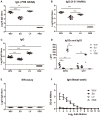Cross-Protective Immune Responses Induced by Sequential Influenza Virus Infection and by Sequential Vaccination With Inactivated Influenza Vaccines
- PMID: 30356772
- PMCID: PMC6189474
- DOI: 10.3389/fimmu.2018.02312
Cross-Protective Immune Responses Induced by Sequential Influenza Virus Infection and by Sequential Vaccination With Inactivated Influenza Vaccines
Abstract
Sequential infection with antigenically distinct influenza viruses induces cross-protective immune responses against heterologous virus strains in animal models. Here we investigated whether sequential immunization with antigenically distinct influenza vaccines can also provide cross-protection. To this end, we compared immune responses and protective potential against challenge with A(H1N1)pdm09 in mice infected sequentially with seasonal A(H1N1) virus followed by A(H3N2) virus or immunized sequentially with whole inactivated virus (WIV) or subunit (SU) vaccine derived from these viruses. Sequential infection provided solid cross-protection against A(H1N1)pdm09 infection while sequential vaccination with WIV, though not capable of preventing weight loss upon infection completely, protected the mice from reaching the humane endpoint. In contrast, sequential SU vaccination did not prevent rapid and extensive weight loss. Protection correlated with levels of cross-reactive but non-neutralizing antibodies of the IgG2a subclass, general increase of memory T cells and induction of influenza-specific CD4+ and CD8+ T cells. Adoptive serum transfer experiments revealed that despite lacking neutralizing activity, serum antibodies induced by sequential infection protected mice from weight loss and vigorous virus growth in the lungs upon A(H1N1)pdm09 virus challenge. Antibodies induced by WIV vaccination alleviated symptoms but could not control virus growth in the lung. Depletion of T cells prior to challenge revealed that CD8+ T cells, but not CD4+ T cells, contributed to cross-protection. These results imply that sequential immunization with WIV but not SU derived from antigenically distinct viruses could alleviate the severity of infection caused by a pandemic and may improve protection to unpredictable seasonal infection.
Keywords: antigenically distinct influenza virus strains; cross-protection; immune mechanism; non-neutralizing antibody; sequential vaccination.
Figures






Similar articles
-
Induction of heterosubtypic cross-protection against influenza by a whole inactivated virus vaccine: the role of viral membrane fusion activity.PLoS One. 2012;7(1):e30898. doi: 10.1371/journal.pone.0030898. Epub 2012 Jan 27. PLoS One. 2012. PMID: 22303469 Free PMC article.
-
Inactivated H7 Influenza Virus Vaccines Protect Mice despite Inducing Only Low Levels of Neutralizing Antibodies.J Virol. 2017 Sep 27;91(20):e01202-17. doi: 10.1128/JVI.01202-17. Print 2017 Oct 15. J Virol. 2017. PMID: 28768855 Free PMC article.
-
Cross-Protective Potential and Protection-Relevant Immune Mechanisms of Whole Inactivated Influenza Virus Vaccines Are Determined by Adjuvants and Route of Immunization.Front Immunol. 2019 Mar 29;10:646. doi: 10.3389/fimmu.2019.00646. eCollection 2019. Front Immunol. 2019. PMID: 30984200 Free PMC article.
-
Innovative Mucosal Vaccine Formulations Against Influenza A Virus Infections.Front Immunol. 2019 Jul 17;10:1605. doi: 10.3389/fimmu.2019.01605. eCollection 2019. Front Immunol. 2019. PMID: 31379823 Free PMC article. Review.
-
Inactivation methods for whole influenza vaccine production.Rev Med Virol. 2019 Nov;29(6):e2074. doi: 10.1002/rmv.2074. Epub 2019 Jul 23. Rev Med Virol. 2019. PMID: 31334909 Review.
Cited by
-
Lung structural cells are altered by infeluenza virus leading to rapid immune protection following re-challenge.Nat Commun. 2025 Aug 1;16(1):7061. doi: 10.1038/s41467-025-62364-y. Nat Commun. 2025. PMID: 40750594 Free PMC article.
-
Prolonging the delivery of influenza virus vaccine improves the quantity and quality of the induced immune responses in mice.Front Immunol. 2023 Oct 5;14:1249902. doi: 10.3389/fimmu.2023.1249902. eCollection 2023. Front Immunol. 2023. PMID: 37869002 Free PMC article.
-
Immunogenicity and protective efficacy of an intranasal neuraminidase-based influenza vaccine with bacterial cell membrane-derived adjuvants.NPJ Vaccines. 2025 Jul 10;10(1):149. doi: 10.1038/s41541-025-01209-7. NPJ Vaccines. 2025. PMID: 40640198 Free PMC article.
-
Recombinant Live Attenuated Influenza Vaccine Viruses Carrying Conserved T-cell Epitopes of Human Adenoviruses Induce Functional Cytotoxic T-Cell Responses and Protect Mice against Both Infections.Vaccines (Basel). 2020 Apr 24;8(2):196. doi: 10.3390/vaccines8020196. Vaccines (Basel). 2020. PMID: 32344618 Free PMC article.
-
Repeated vaccination against matched H3N2 influenza virus gives less protection than single vaccination in ferrets.NPJ Vaccines. 2019 Jul 9;4:28. doi: 10.1038/s41541-019-0123-7. eCollection 2019. NPJ Vaccines. 2019. PMID: 31312528 Free PMC article.
References
Publication types
MeSH terms
Substances
LinkOut - more resources
Full Text Sources
Medical
Research Materials

